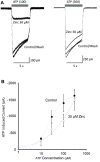Physiological Concentrations of Zinc Have Dual Effects on P2X Myenteric Receptors of Guinea Pig
- PMID: 30109516
- PMCID: PMC11481950
- DOI: 10.1007/s10571-018-0612-7
Physiological Concentrations of Zinc Have Dual Effects on P2X Myenteric Receptors of Guinea Pig
Abstract
We, hereby, characterize the pharmacological effects of physiological concentrations of Zinc on native myenteric P2X receptors from guinea-pig small intestine and on P2X2 isoforms present in most myenteric neurons. This is the first study describing opposite effects of Zinc on these P2X receptors. It was not possible to determine whether both effects were concentration dependent, yet the inhibitory effect was mediated by competitive antagonism and was concentration dependent. The potentiating effect appears to be mediated by allosteric changes induced by Zinc on P2X myenteric channels, which is more frequently observed in myenteric neurons with low zinc concentrations. In P2X2-1 and P2X2-2 variants, the inhibitory effect is more common than in P2X myenteric channels. However, in the variants, the potentiatory effect is of equal magnitude as the inhibitory effect. Inhibitory and potentiatory effects are likely mediated by different binding sites that appear to be present on both P2X2 variants. In conclusion, in myenteric native P2X receptors, Zinc has quantitatively different pharmacological effects compared to those observed on homomeric channels: P2X2-1 and P2X2-2. Potentiatory and inhibitory Zinc effects upon these receptors are mediated by two different binding sites. All our data suggest that myenteric P2X receptors have a more complex pharmacology than those of the recombinant P2X2 receptors, which is likely related to other subunits known to be expressed in myenteric neurons. Because these dual effects occur at Zinc physiological concentrations, we suggest that they could be involved in physiological and pathological processes.
Keywords: ATP; Gastrointestinal tract; Myenteric neurons; P2X native receptors; P2X2 recombinant receptors; Zinc.
Conflict of interest statement
The authors declare the lack of any conflict of interest.
Figures






Similar articles
-
Retention of a new-defined intron changes pharmacology and kinetics of the full-length P2X2 receptor found in myenteric neurons of the guinea pig.Neuropharmacology. 2012 Sep;63(3):394-404. doi: 10.1016/j.neuropharm.2012.04.002. Epub 2012 Apr 22. Neuropharmacology. 2012. PMID: 22546617
-
Molecular mechanisms of cross-inhibition between nicotinic acetylcholine receptors and P2X receptors in myenteric neurons and HEK-293 cells.Neurogastroenterol Motil. 2010 Aug;22(8):901-8, e235. doi: 10.1111/j.1365-2982.2010.01505.x. Epub 2010 Apr 23. Neurogastroenterol Motil. 2010. PMID: 20426799 Free PMC article.
-
P2X4 subunits are part of P2X native channels in murine myenteric neurons.Eur J Pharmacol. 2013 Jun 5;709(1-3):93-102. doi: 10.1016/j.ejphar.2013.03.045. Epub 2013 Apr 6. Eur J Pharmacol. 2013. PMID: 23567069
-
P2X receptors in peripheral neurons.Prog Neurobiol. 2001 Oct;65(2):107-34. doi: 10.1016/s0301-0082(01)00005-3. Prog Neurobiol. 2001. PMID: 11403876 Review.
-
P2X1 and P2X2 receptors in the central nervous system as possible drug targets.CNS Neurol Disord Drug Targets. 2012 Sep;11(6):675-86. doi: 10.2174/187152712803581128. CNS Neurol Disord Drug Targets. 2012. PMID: 22963438 Review.
References
-
- Barajas-Lopez C, Barrientos M, Espinosa-Luna R (1993) Suramin increases the efficacy of ATP to activate an inward current in myenteric neurons from guinea-pig ileum. Eur J Pharmacol 250:141–145 - PubMed
-
- Barajas-Lopez C, Peres AL, Espinosa-Luna R (1996b) Cellular mechanisms underlying adenosine actions on cholinergic transmission in enteric neurons. Am J Physiol 271:C264–C275 - PubMed
-
- Barajas-Lopez C, Espinosa-Luna R, Christofi FL (2000) Changes in intracellular Ca2+ by activation of P2 receptors in submucosal neurons in short-term cultures. Eur J Pharmacol 409:243–257. 10.1016/S0014-2999(00)00848-7 - PubMed
MeSH terms
Substances
Grants and funding
LinkOut - more resources
Full Text Sources
Other Literature Sources
Miscellaneous

